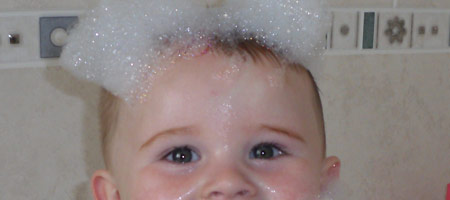Bath Time
Advice on full baths, sponge baths and topping and tailing.

Not all babies enjoy bath-time, and shampooing can be a nightmare. If your little one has become anxious about bathing, skip it for a night or two. Then, allow him or her to sit in the bathtub, with no water in it, just to get used to the routine again.
If baby doesn't like his/her hair being rinsed by water poured from a container, try getting a shower head connection.
Finally, make sure you have a non-slip mat in the bath and invest in lots of toys to keep bathing interesting.
As your child grows up they can become more adamant as to what they like and don't like (bathtime being one of these).
Bath Time Tips
Full Bath
When giving your baby a full bath, you will need:
- cotton wool
- a flannel or sponge
- baby bath liquid or soap
- baby shampoo
- a clean nappy
- your usual nappy-changing equipment
Put the baby bath on a firm, flat surface at a comfortable height. If you don’t have a baby bath, use a clean washing-up bowl or the kitchen or bathroom sink. Put the cold water in first, to avoid scalds. Never add hot water while the baby is in the bath. Once your baby is undressed, wrap him/her in a towel. Now, clean the face and eyes gently with cotton wool moistened in warm water. Then take off the towel and slip your baby into the bath.
Put the baby bath on a firm, flat surface at a comfortable height
Support the head, neck and shoulders all the time while in the water and use your free hand to wash him/her.
Sponge Bath
Start by cleaning your baby’s eyes and face with moistened cotton wool. Then take off his/her vest and do baby’s top half (back and front). Next, use a sponge or a flannel dipped in warm water, sponge him/her down gently. You won’t need soap or baby bath liquid unless your baby is very dirty. Pay particular attention to the folds of skin. Rinse with a squeezed-out sponge or cloth and pat dry.
If you want to wash your baby's hair, do so before replacing his/her vest. Just moisten the head with the sponge and shampoo with a little baby shampoo. Rinse and pat dry.
Next, put on your baby’s vest and then wash the nappy area, rinsing with fresh water and patting dry.
Keep the flannel or sponge you use to clean your baby’s bottom separate andremember to wash your hands after changing a nappy. Finally, wash and dry the legs and feet and put on a clean nappy and fresh clothes.
Topping and Tailing
Lay baby on a firm surface, such as the place you use to change him/her. If your baby’s eyes are sticky or crusty, clean them with cotton wool moistened in water that has been boiled and cooled. Work from the nose outwards and use a different piece of cotton wool for each eye.
Then clean around and behind his/her ears, but don’t poke anything into them. Give his/her face and hands a wipe over too. Take off the nappy and clean around their bottom with damp cotton wool or a nappy wipe. If he/she has a dirty nappy, clean off as much as possible with the nappy and finish with cotton wool or a nappy wipe and baby lotion. Use damp cotton wool to clean off any urine. Put on cream, if that’s what you're using, and a clean nappy.
For advice and useful tips, be sure to visit Everymom's bathing and skincare section.
